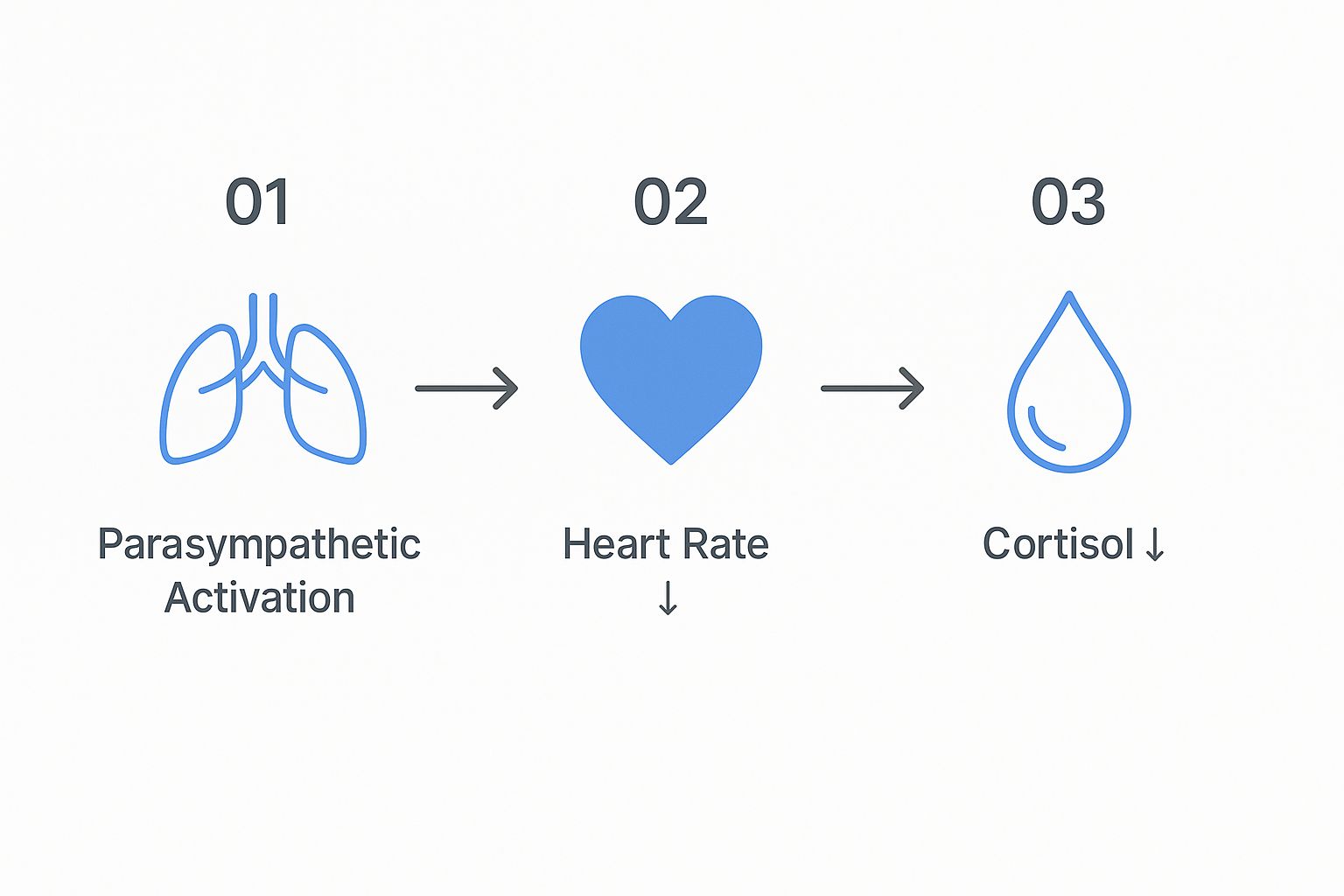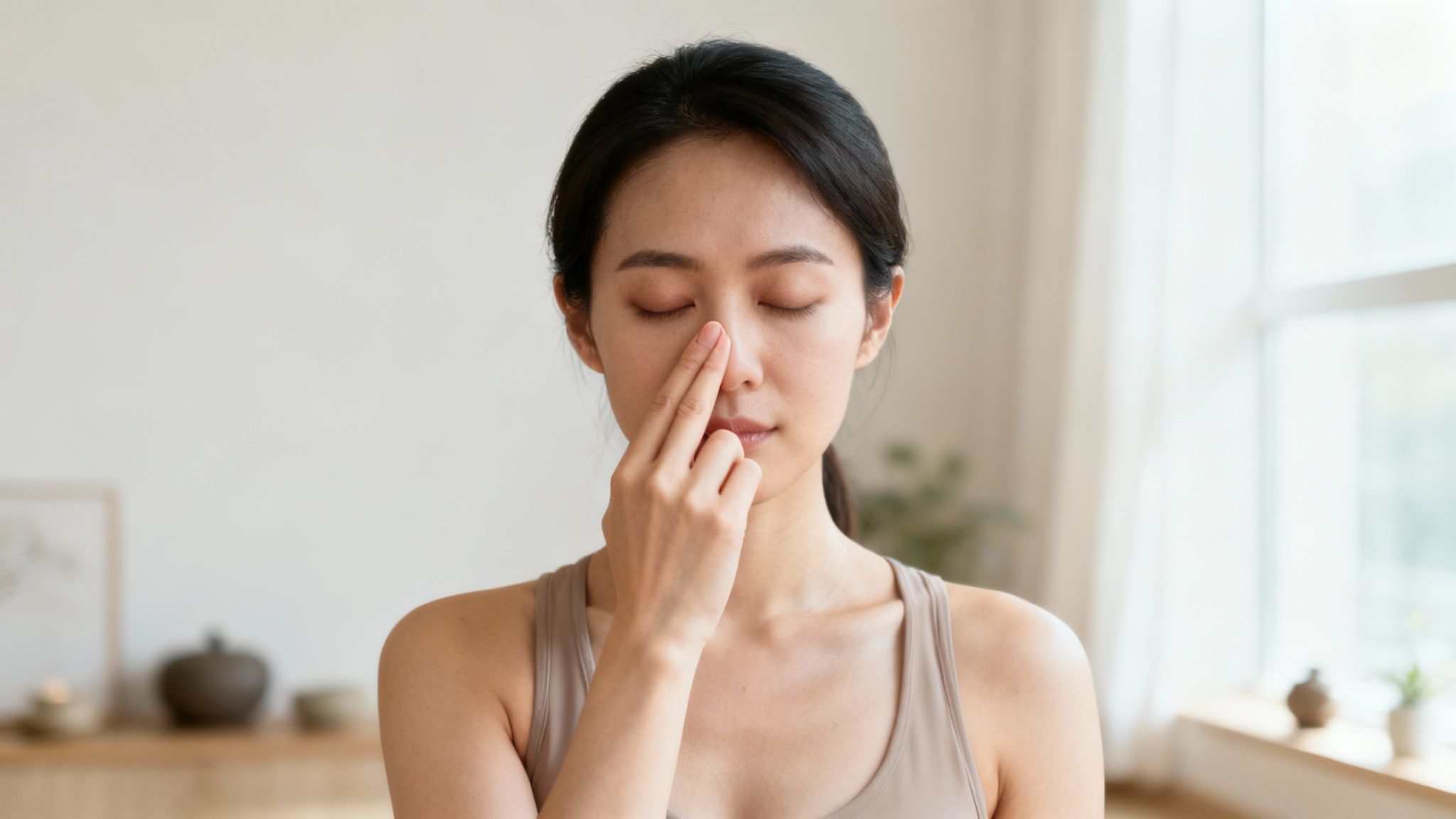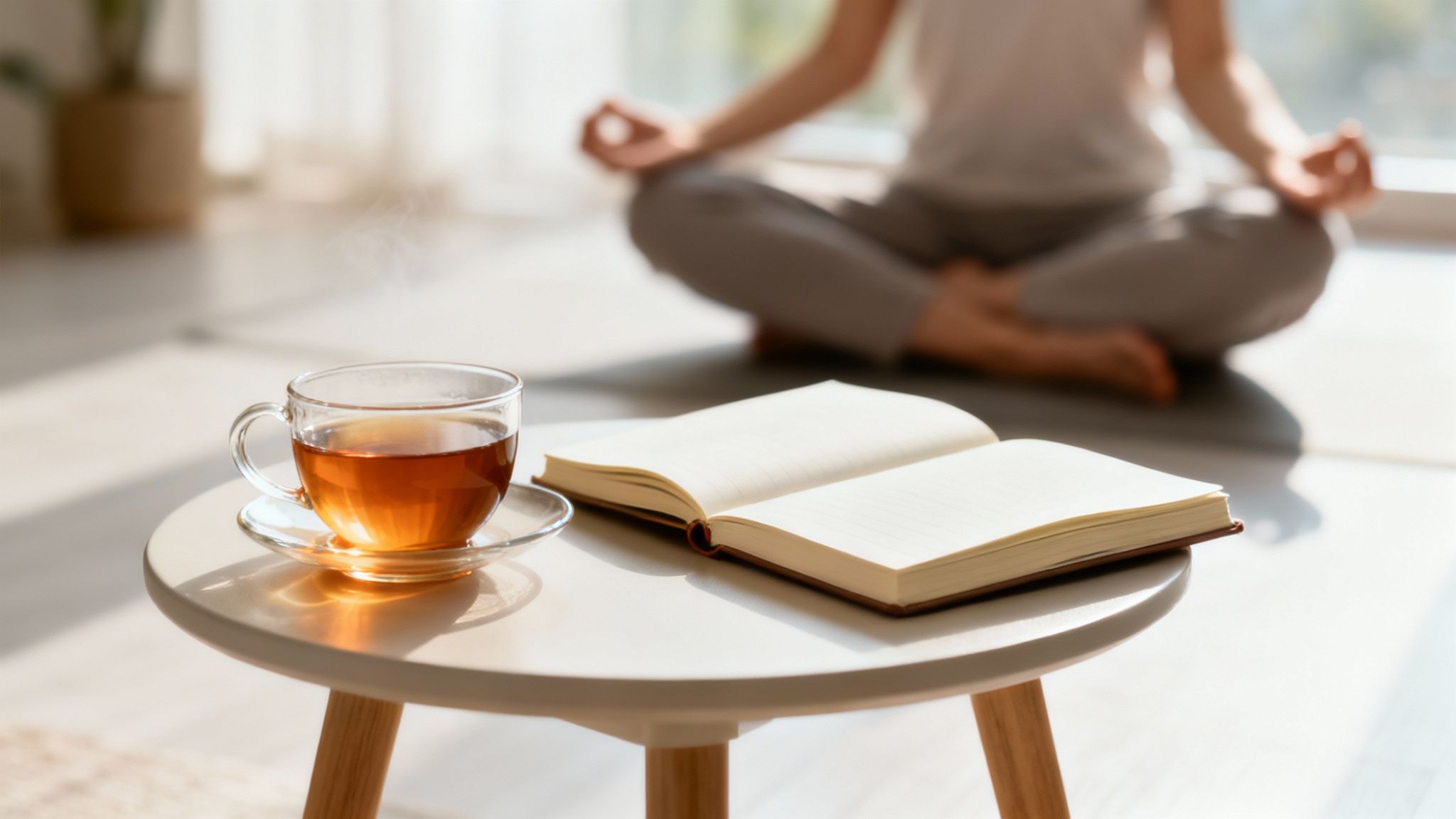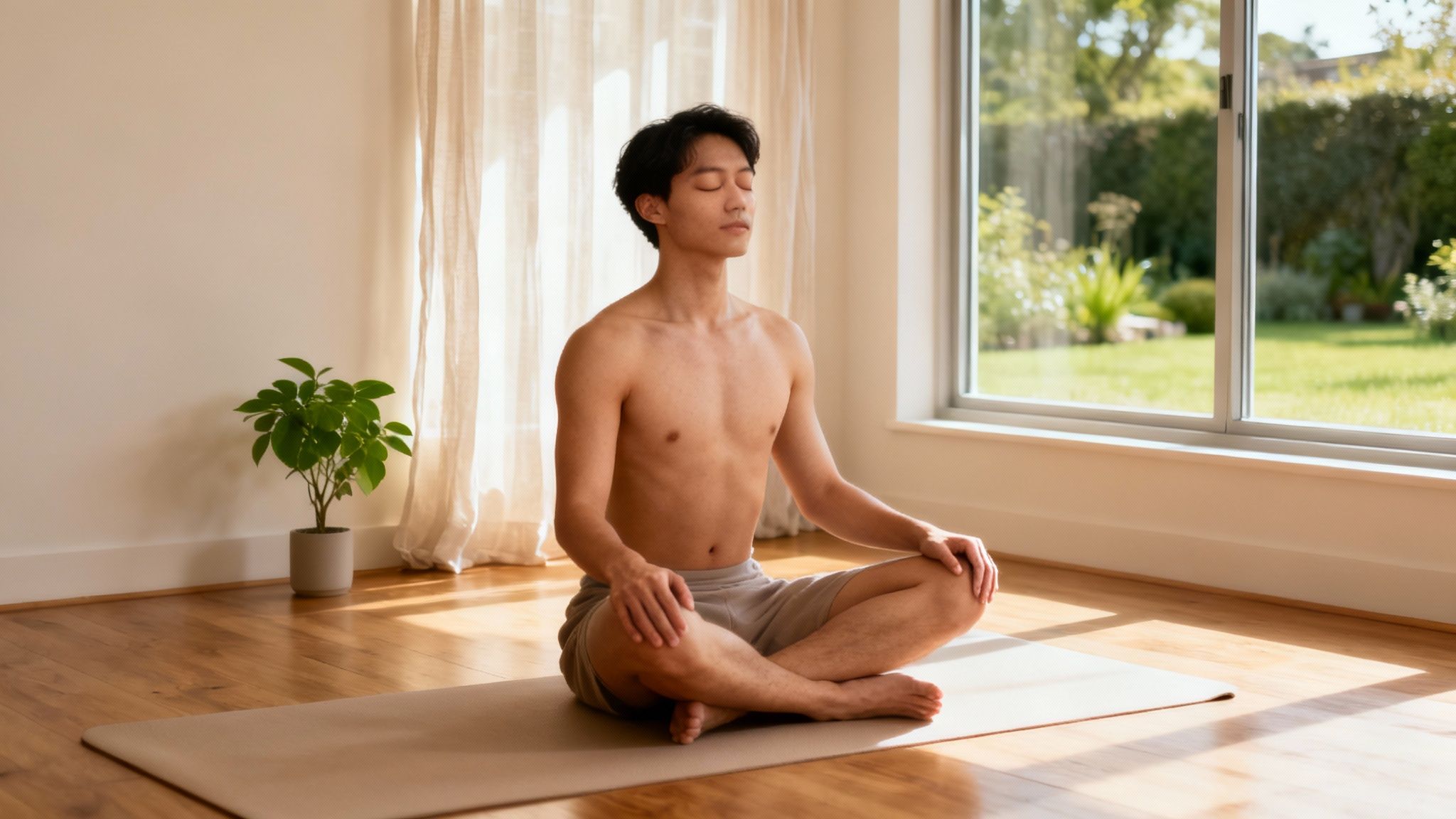When anxiety feels overwhelming and your mind starts racing, intentional breathing—or pranayama—can be a powerful way to find your balance. By consciously slowing your breath, you can interrupt the cycle of worry and gently guide your body back to a state of calm. It’s a simple, science-backed tool you can use anywhere to manage the challenging feelings of anxiety.
Finding Your Calm in a Hectic World

Feeling overwhelmed can seem like the new normal. The constant juggle of work and personal life can easily lead to burnout and persistent workplace stress. In this environment, finding a true moment of peace can feel almost impossible.
This relentless pressure often appears as anxiety, trapping your mind in a loop of worries. You might feel it physically—a tight chest, a knot in your stomach, or shallow breaths. These are signs your body is in a state of high alert.
Anchoring Yourself with Breath
This is where the ancient Indian practice of pranayama, or conscious breathing, can help. At its heart, pranayama is about regulating your breath to shift your state of mind. It's a practical technique for anyone looking to build a bit more resilience.
When you intentionally slow your breath, you send a direct signal to your nervous system to calm the stress response. Focusing on your inhales and exhales can pull you out of anxious thoughts and anchor you in the present moment.
The benefits are well-documented. Research published in the Indian Journal of Psychological Medicine has shown how powerful these practices are for mental well-being. One study found a significant drop in anxiety scores for participants after just three months of consistent practice. You can explore the full research paper to see the data.
More Than Just Breathing
Using pranayama for anxiety is an act of self-compassion. Each mindful breath is a small gesture of kindness toward yourself. It's a way to navigate life's challenges with more clarity, helping you build emotional balance one breath at a time.
Please remember: This guide offers informational support, not a diagnosis. While pranayama is a wonderful practice for well-being, it is not a substitute for professional therapy or counselling. If you are struggling, please connect with a qualified mental health professional.
Starting with gentle techniques can make the practice feel more approachable. Here are three simple exercises perfect for beginners.
Three Gentle Pranayama Techniques for Beginners
| Technique Name | Primary Benefit | Best For |
|---|---|---|
| Belly Breathing (Diaphragmatic Breathing) | Deep relaxation and calming the nervous system | Moments of acute stress or before sleep |
| Alternate Nostril Breathing (Nadi Shodhana) | Balancing the mind and promoting mental clarity | When feeling scattered or mentally foggy |
| Box Breathing (Sama Vritti) | Focusing the mind and regulating stress hormones | Pre-meeting jitters or during a stressful task |
Each of these offers a unique way to connect with your breath and can be a fantastic starting point on your journey to a calmer mind.
How Conscious Breathing Calms Your Nervous System
Ever feel a sudden wave of anxiety? Your heart pounds, your breathing gets shallow, and your thoughts race. That's your sympathetic nervous system—your body's "fight or flight" alarm—kicking into high gear.
Conscious breathing, the core of pranayama, is like an override switch. When you intentionally slow and deepen your breath, you signal to your body that it is safe. This simple act activates the parasympathetic nervous system, your body's "rest and digest" mode, which fosters a feeling of calm.
This is a physiological process. Slow, deliberate breathing tells your brain the threat has passed. In response, your body reduces stress hormones like cortisol, helping you feel grounded and centred again.
The Science of a Simple Breath
When you practise pranayama for anxiety, you directly influence the systems that stress disrupts. Think of it as communicating with your body in the simple, powerful language of breath.
The process is straightforward but creates a profound ripple effect. This infographic breaks down how a simple breathing exercise can trigger significant physiological shifts toward calm.

As you can see, activating this relaxation response starts a chain reaction that directly counters the physical effects of anxiety. This simple sequence can make a huge difference in how you feel in the moment.
The most empowering part of this process is that it puts you back in control. Instead of feeling helpless against waves of anxiety or workplace stress, you have a practical tool to self-regulate and restore balance.
Building Resilience One Breath at a Time
Every time you practice, you strengthen this calming pathway in your nervous system, much like exercising a muscle. With consistency, your body becomes more efficient at shifting out of stress mode. This is how you build long-term resilience, making you less reactive to triggers over time.
Of course, this isn't about eliminating stress or anxiety entirely; they are normal parts of life. It’s about changing your relationship with them. While conscious breathing is powerful on its own, adding complementary elements like exploring matcha's calming health benefits, particularly L-theanine, can give your nervous system even more support.
Remember, this practice is an act of self-compassion. The goal is not perfection but finding a supportive practice that enhances your overall well-being and helps you navigate life's challenges with more ease and happiness.
Your Guide to Calming Pranayama Practices

Now that we've covered how breathing can shift your nervous system, let's get practical. Here are a few gentle, hands-on practices you can do almost anywhere.
Whether you're feeling pressure at your desk or seeking peace at home, these techniques are accessible. The goal isn't to achieve a perfect breathing pattern, but to find a rhythm that feels good for you.
Each of these pranayama exercises offers a slightly different way to manage feelings of anxiety. The most important thing is to listen to your body and return to your normal breath if anything feels strained. This is an act of self-kindness, not a performance.
Nadi Shodhana: The Balancing Breath
Nadi Shodhana, or Alternate Nostril Breathing, is an incredibly grounding technique. It is especially helpful when your mind feels scattered, bringing clarity and balance to the nervous system.
Imagine you're about to give a presentation and your heart is pounding. Taking just two or three minutes for Nadi Shodhana can centre your mind, helping you proceed with more calm and focus.
Here’s a simple way to begin:
- Find a comfortable seated position with a tall but relaxed spine.
- Rest your left hand on your left knee. With your right hand, fold your index and middle fingers toward your palm.
- Gently close your right nostril with your thumb and inhale slowly through your left nostril.
- Close your left nostril with your ring finger, release your thumb, and exhale smoothly through the right nostril.
- Now, inhale through the right nostril, then close it with your thumb and exhale through the left. This completes one full round.
- Continue for 5-10 rounds, focusing on a smooth, easy flow of breath.
Ujjayi: The Victorious Breath
Ujjayi Pranayama, or the Victorious Breath, creates a soft, oceanic sound at the back of your throat. This slight narrowing of the airway naturally slows your breathing, which has a deeply soothing effect on the nerves.
This technique is helpful for moments of sudden frustration or rising anxiety. The audible rhythm of the Ujjayi breath gives your mind a steady anchor, pulling your attention away from the stressor.
What’s wonderful about Ujjayi is its subtlety. You can practise it anywhere without drawing attention, making it a discreet tool for managing anxiety in public or during a stressful meeting.
To try Ujjayi:
- Sit comfortably and notice your natural breath flowing through your nose.
- Gently constrict the muscles at the back of your throat, as if you were about to whisper.
- As you continue breathing through your nose, you will hear a soft, whisper-like sound, similar to ocean waves.
- Try to keep the breath long, smooth, and even on both the inhalation and exhalation.
Bhramari: The Humming Bee Breath
Bhramari Pranayama, or Humming Bee Breath, uses the power of vibration to soothe the mind. The gentle humming sound resonates through your skull, which can quieten racing thoughts and release built-up tension and anxiety.
This is a wonderful practice to unwind with at the end of a long day. It signals to your mind that it’s time to shift from high alert to rest, and its effects are often immediate.
One Indian study with people in home isolation during the COVID-19 pandemic found that 20 minutes of daily Bhramari practice over 15 days led to major reductions in stress, anxiety, and depression. Participants reported significant improvements in their psychological health. You can read more about these powerful pranayama findings.
While pranayama is a great starting point, pairing it with other mindfulness practices like essential meditation techniques can deepen your sense of calm. Think of these as a toolkit of skills to help you navigate life’s challenges with greater ease.
Weaving Pranayama Into Your Everyday Life

Knowing how to practice pranayama is one thing; making it a part of your life is another. The key is to avoid making it another chore. Instead, sprinkle these breathing practices throughout your day so they feel like a lifeline.
The biggest hurdle is often time. But you don't need a full hour on a yoga mat. You can see real benefits with just five minutes a day, as consistency is more important than duration.
Finding Your Moments
An easy way to build a new habit is to attach it to something you already do every day. This simple trick, called "habit stacking," works because you're not trying to reinvent your schedule.
Think about the natural pauses in your day. Could you fit a practice in then?
- With your morning tea or coffee: While the water boils, try five rounds of Nadi Shodhana. It's a centering way to begin your day.
- Before you commute: Before you leave the house, take three deep, intentional breaths to set a calm tone for your journey.
- As a lunchtime reset: Before you eat, do two minutes of Ujjayi breathing to release any workplace stress from the morning.
This approach transforms your practice from an obligation into a welcome pause. You are simply filling small pockets of time with a moment of self-care.
Remember, the goal is not perfection; it's presence. One mindful breath when you feel anxiety rising is a victory. That single breath builds incredible resilience over time.
Creating a Supportive Space
You don't need a special meditation room. A comfortable chair in a quiet corner where you won't be interrupted for five minutes is all you need.
It can help to make this spot feel inviting, perhaps with a small plant or a favourite cushion. These small visual cues signal to your brain that it's time to slow down, which can make you look forward to your practice.
Overcoming the Inevitable Hurdles
You will miss days, and that's completely normal. The important part is to return to your practice the next day without guilt.
Your mind will wander. When you notice you’re thinking about your to-do list, gently guide your focus back to your breath without judgment. The practice isn't about having an empty mind; it's about the act of returning, again and again, to your anchor.
Ultimately, making pranayama for anxiety work for you is about flexibility. It's a gentle, consistent effort that can be a powerful tool for managing anxiety and depression, especially alongside professional support like therapy or counselling.
A Few Important Things to Keep in Mind
Starting a pranayama practice is a wonderful way to build a kinder relationship with your mind. It’s a journey, not a race. To ensure that journey is safe and supportive, it helps to remember a few simple guidelines.
The most important rule is to listen to your body. It is your best teacher.
If any breathing technique feels strained or uncomfortable, that is your body's signal to ease off. This is not about pushing through discomfort; it is about finding a rhythm that feels nurturing for you.
Honouring Your Body’s Limits
It's normal to feel a bit light-headed when you're just starting out. If that happens, simply stop and let your breath return to its natural pattern. Your body is just adjusting to something new.
This whole practice is about creating well-being, not chasing perfection. Pushing too hard will only create more stress. Be gentle with yourself, and your capacity will grow over time.
A crucial reminder: This guide is for informational support, not as a medical assessment. Think of these tools as a way to understand yourself better, not as a substitute for a professional evaluation or diagnosis.
Pranayama Is a Supportive Tool, Not a Replacement
Breathing practices can make a huge difference in how you experience anxiety and build your resilience. But they are not a substitute for professional mental healthcare.
Think of pranayama for anxiety as a powerful addition to your mental health toolkit. It works beautifully alongside, not instead of, professional guidance from therapy or counselling. If you are dealing with persistent anxiety or depression, reaching out to a professional is a sign of strength.
Pranayama in High-Stress Environments
The need for simple ways to manage stress is universal, especially in high-pressure jobs. In India, for example, the immense demands on frontline workers have highlighted this need.
A study on Indian doctors during the pandemic found high rates of stress and depression. While not about pranayama specifically, it shows how much professionals in these fields could benefit from grounding techniques. You can explore the research on frontline worker stress.
Your pranayama practice is a personal journey. By approaching it with self-awareness, compassion, and professional support when needed, you are building a path toward greater emotional balance and lasting well-being.
Your Questions on Pranayama and Anxiety, Answered
As you explore how pranayama can help with anxiety, you're bound to have questions. This is a great sign that you're engaging with the practice.
Let's walk through some common queries to bring more clarity to your practice. Remember, this is for informational purposes, and it's always best to consult a professional for personal medical advice.
How Quickly Will I Actually Feel a Difference?
This is a common question. Many people feel a shift right away. Even after a five-minute session, you might notice your mental chatter quietening and physical tension easing.
For deeper, more lasting change, consistency is key. Committing to a few minutes each day helps build your resilience to workplace stress and general anxiety. Over a few weeks, you may notice positive shifts in your overall well-being.
One session can offer a moment of peace. A consistent practice teaches your mind and body how to create that peace for themselves, especially when things get tough.
Can I Do This if I Have a Medical Condition?
Your health and safety always come first. If you're managing a condition like asthma, high blood pressure, or heart-related issues, please speak with your doctor before starting.
While most of these exercises are gentle, some involve breath-holding or energetic breathing that might not be right for everyone. A chat with your doctor or a qualified instructor can help you find safe modifications. This ensures your journey with pranayama for anxiety supports your unique health needs.
Is Pranayama a Replacement for Therapy?
This is an important question, and the short answer is no. Pranayama is a powerful, supportive tool, not a substitute for professional help. It works wonderfully alongside therapy or counselling to help manage anxiety and depression.
If you're struggling, reaching out to a qualified therapist is a sign of strength. They can provide a proper assessment (which is informational, not a fixed label) and work with you on a structured plan. Weaving pranayama into that plan can be a fantastic way to support your progress.
At DeTalks, we know that finding the right support is the first step towards building a more resilient and fulfilling life. If you're looking for professional guidance, our platform can connect you with qualified therapists who are ready to support you. Explore our network of professionals and take that next step today.
